It may be unsettling to see thriving spider populations amongst your favorite flowers and bushes, but spiders are actually helpful creatures and can help you produce a beautiful garden. The most significant benefit of having spiders in your yard is that they eat unwanted pests like aphids, wasps, mosquitos, flies, and beetles. They create a healthy balance in your green space and prevent the spread of harmful plant pathogens. Find out all about these 29 garden spiders in Texas.
1. Yellow Garden Spider

The yellow garden spider inhabits backyard gardens throughout Texas.
©iStock.com/AwakenedEye
The yellow garden spider is a large arachnid with a black abdomen and symmetrical yellow patches. Yellow garden spiders are in backyard gardens throughout the United States, Canada, Mexico, and Central America. They spin their circular web in sunny areas, anchoring it to plants. The yellow garden spider produces venom that immobilizes its prey like flies and bees, but it’s harmless to humans.
2. Rabid Wolf Spider

The rabid wolf spider is native to North America and prefers fields and wooded habitats.
©Brett Hondow/Shutterstock.com
While not actually rabid, this spider gets its name from its erratic and fast movements. The rabid wolf spider appears aggressive and will posture as though it may attack you, but it’s quite harmless and won’t bite unless literally (and figuratively) back into a corner. It is native to North America and prefers fields and wooded habitats. You can also find it near ponds. Most often, it will blend in with leaves and bark. Don’t be surprised if this spider wanders into gardens near heavily wooded areas.
3. Green Lynx Spider
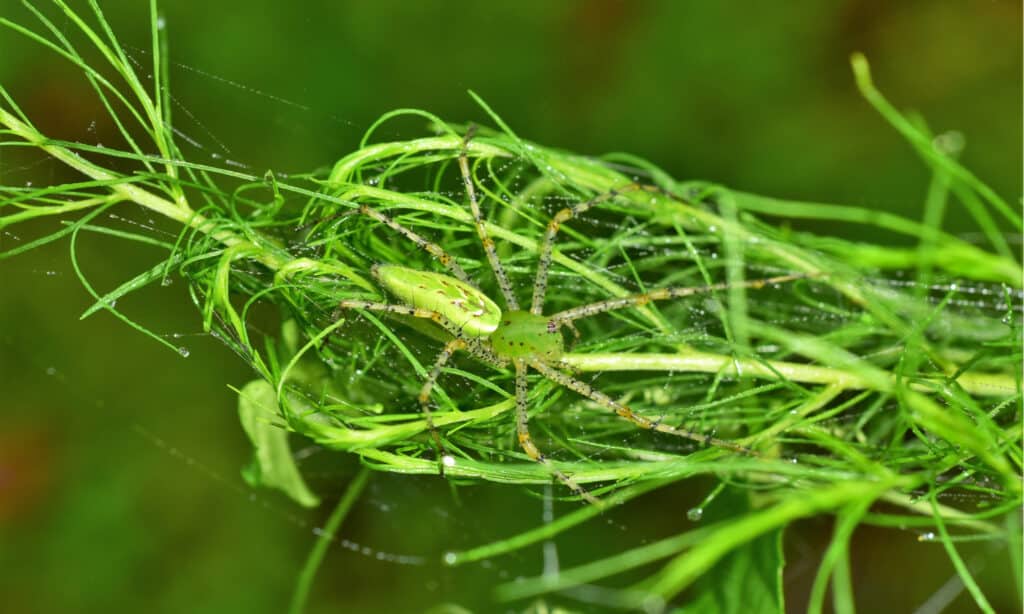
The green lynx spider is used in agricultural pest management.
©Ken Beard/Shutterstock.com
You can find this large, bright green spider on shrub-like plants throughout the Southern United States. Commonly used in agricultural pest management, it is one of the top predators of insects in low-lying shrubs and herbaceous vegetation. While it aggressively attacks its prey, it is inoffensive to humans.
4. Striped Lynx Spider
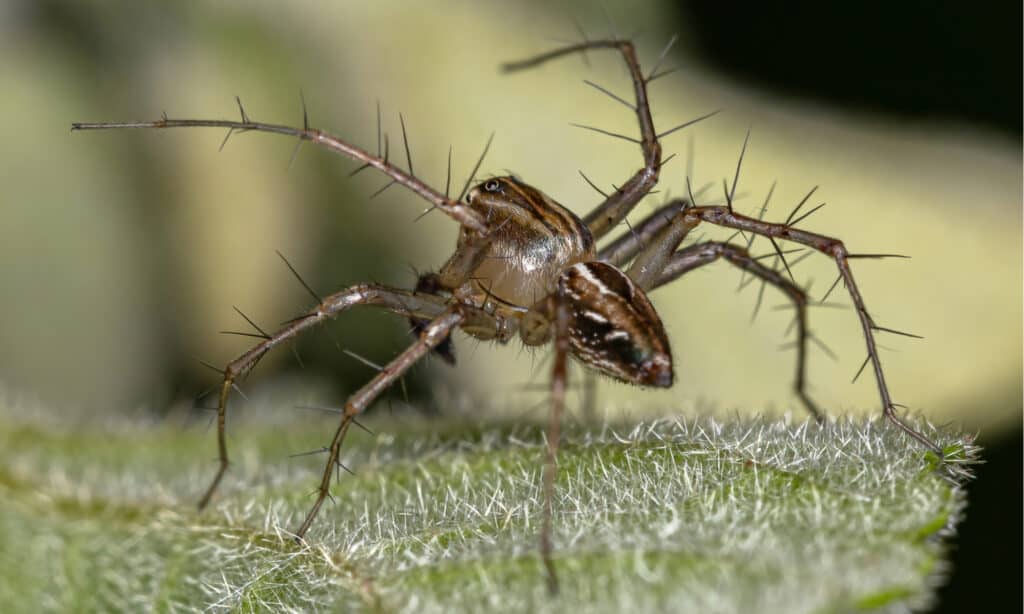
The striped lynx is one of North America’s most abundant garden spiders.
©Vinicius R. Souza/Shutterstock.com
The striped lynx is one of North America’s most abundant garden spiders. It gets its name from its cat-like hunting behavior of slowly sneaking up and pouncing on prey like various insect pests. You can identify this small spider by its spiny legs and the black lines that run down its face. It does not build webs but creates silk supports that rest on vegetation.
5. Bold Jumping Spider

The bold jumping spider is commonly found in gardens, grasslands, and open fields.
©Sari ONeal/Shutterstock.com
This jumping spider is black, with different colored spots and stripes on its abdomen and legs. Juvenile bold jumping spiders typically have orange spots that turn white as they age, and this species will have metallic green or blue mouthparts. Bold jumping spiders are common in open fields, grasslands, and gardens, where they prefer flat, vertical surfaces to chase down prey. Jumping spiders are among the most abundant garden spiders in Texas.
6. Magnolia Green Jumping Spider

The magnolia green jumper gets its name from its bright green color and amazing jumping ability.
©iStock.com/RobertDowner
The magnolia green jumping spider is a tiny jumping spider with bright green color and long, slender legs. This ambush hunter eats plant eaters and is an excellent garden companion. It is venomous but harmless to humans. Magnolia green jumping spiders love warm, humid environments and enjoy being in their favorite habitat, the magnolia tree.
7. Tan Jumping Spider

The tan jumping spider is a minute, furry jumping spider that has large front-facing eyes.
©iStock.com/graphixchon
The tan jumping spider is a minute, furry jumping spider that has large front-facing eyes, making it look mammal-like. It also has eyes that wrap around the sides of its head, giving it a 360-degree vision and allowing it to look for predators and prey. You may not find this spider directly in your garden, but most likely on tree trunks and fence posts surrounding it. Its brown fur lets it blend in easily with these surroundings.
8. Pantropical Jumping Spider
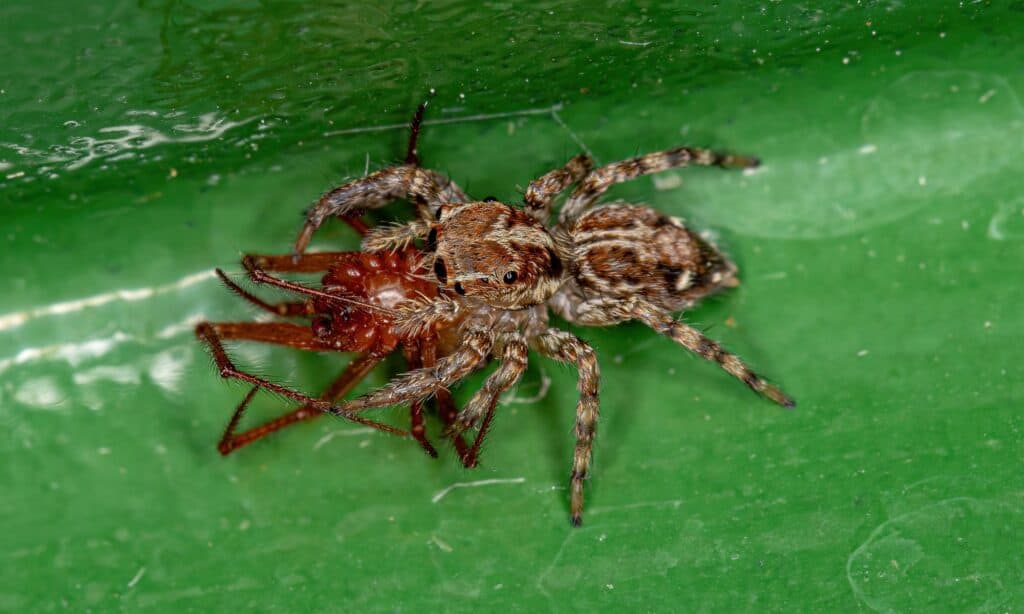
The pantropical jumping spider is native to Southeast Asia.
©Vinicius R. Souza/Shutterstock.com
The pantropical jumping spider is native to Southeast Asia but was introduced to the United States and now inhabits southern areas of the country. You will likely find this spider on the exterior of buildings next to light sources, but it can also populate fields and citrus groves. This species may be relatively small, but it can take down prey twice its size, including cockroaches.
9. Common Hentz Jumping Spider
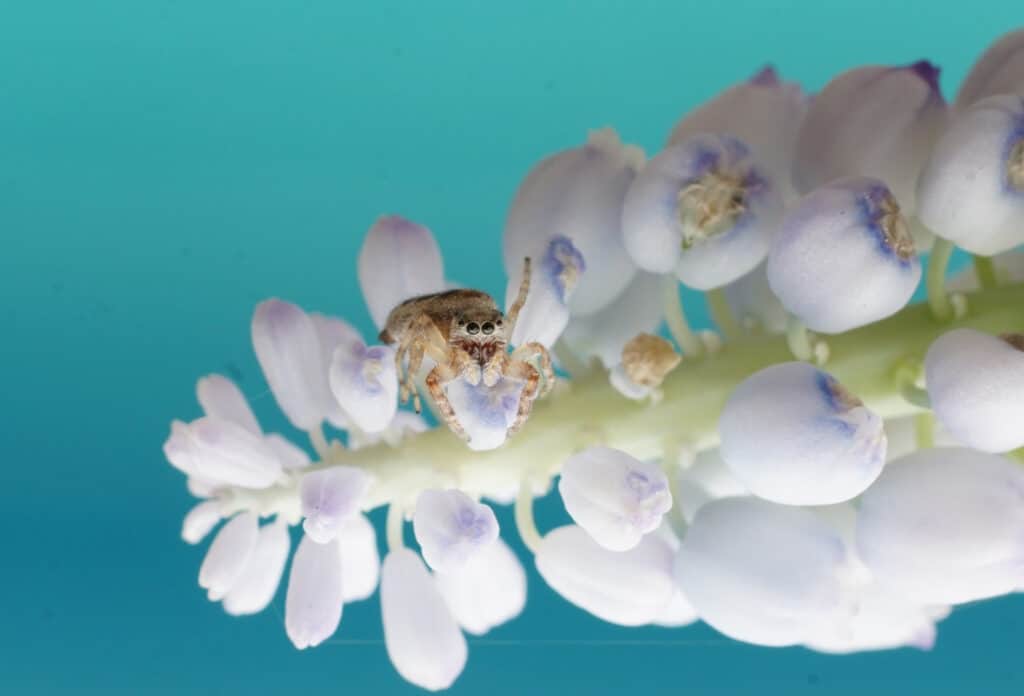
The common hentz is a reddish-brown color with white and dark brown bands.
©iStock.com/Christiane Godin
The common hentz is a reddish-brown color with white and dark brown bands, and it has large front eyes with more minor pairs surrounding it. Instead of spinning a web, this jumping spider, like its relatives, choose to jump on its prey in an ambush-style attack. It will, however, release a strand of spider silk, which it uses to keep its target from escaping. You will likely find this spider on leaf litter or stalking on the ground.
10. Gray Wall Jumping Spider
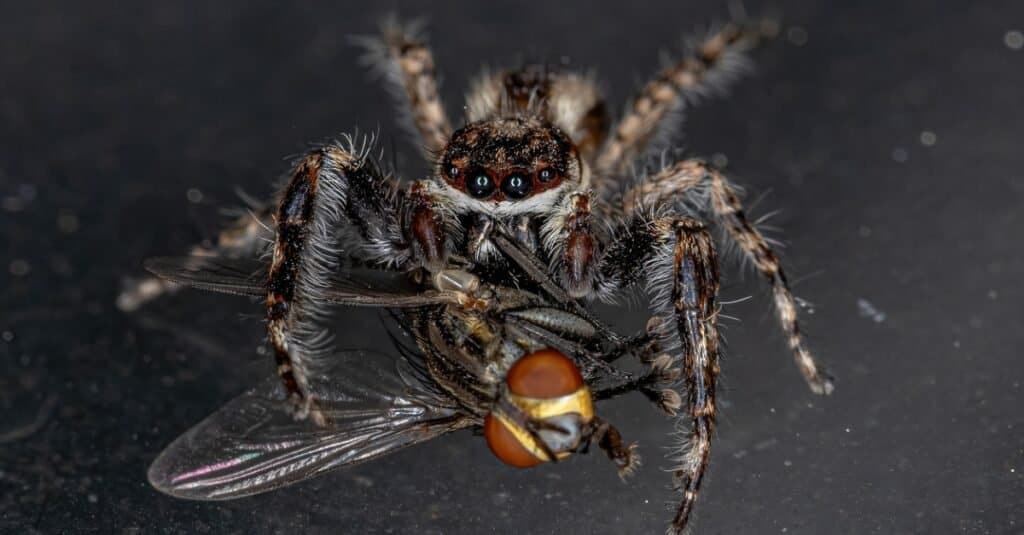
Gray wall jumping spiders prefer blending in with tree trunks in woodland areas.
©iStock.com/ViniSouza128
The gray wall jumping spider is a pantropical species, and you can observe it on tree trunks in woodland areas or on exterior buildings, possibly near a garden. This species is light brown/tan with black bands edged around its back. Female jumping spiders typically lay their eggs in a hidden crevice, which she guards for around three weeks.
11. Dimorphic Jumping Spider

The dimorphic jumping spider has quick movements and neutral colors, making it more conspicuous than other jumping spiders.
©Justin Starr Photography/Shutterstock.com
This species has quick movements and neutral colors, making it more conspicuous than other jumping spiders. This spider is dimorphic, meaning it has two forms. The males can be black with yellow legs or tan with red markings. Further, the females resemble a pale version of the tan male. Like all jumping spiders, this spider can jump great distances in the blink of an eye.
12. Carolina Jumping Spider
Jumping spiders are among the most diverse spider groups in Texas. The Carolina jumping spider is slightly larger than the rest of the salticidae family, and females are much bigger than males. The females are black and orange, and the males tend to be a more solid red or orange.
13. Spiny-backed Orbweaver

The spiny-backed orb weaver is a colorful and oddly shaped arachnid but smaller than other orb-weaver species.
©iStock.com/Weber
The spiny-backed orb weaver is a colorful and oddly shaped arachnid but smaller than other orb-weaver species. It has six pointed red abdominal protrusions or spines; its dorsum is yellow or white, and its legs are black. The spiny-backed orb weaver is not particular about where it takes up residence and can often be in gardens, woodlands, or buildings.
14. Western Spotted Orbweaver
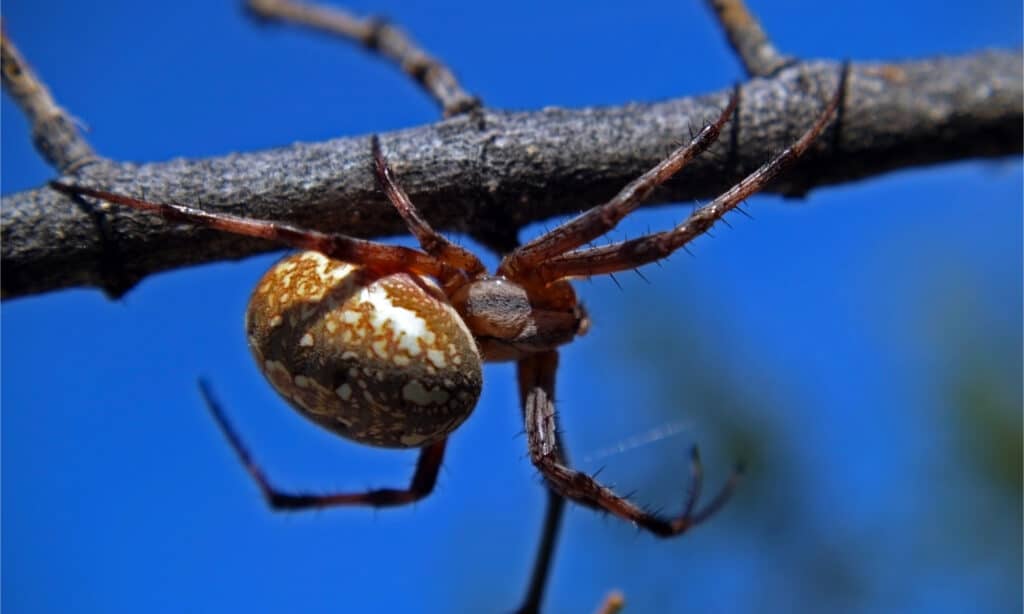
The western spotted orb weaver spins circular webs in open areas, hanging upside down in the center while it waits for prey.
©Deep Desert Photography/Shutterstock.com
The western spotted orb weaver spins circular webs in open areas, hanging upside down in the center while it waits for prey to entangle themselves. This species has a brown bulbous abdomen, yellow speckles, and red or yellow legs with dark bands. Look for this spider in gardens and open fields.
15. Giant Lichen Orbweaver
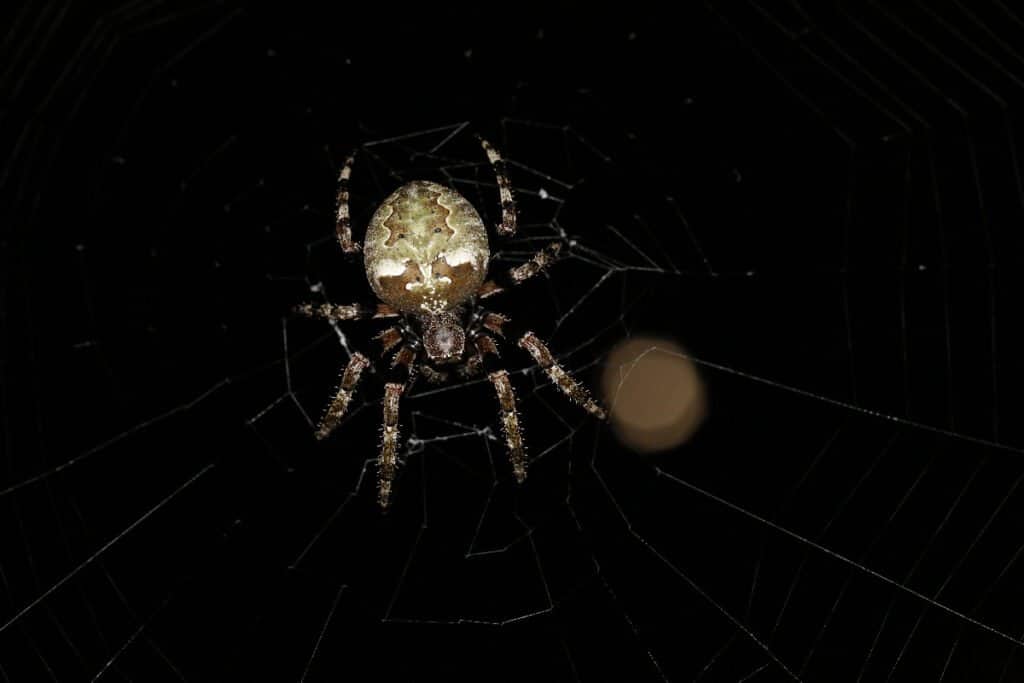
The giant lichen is nocturnal and rarely bothers humans.
©Cathleen Wake Gorbatenko/Shutterstock.com
Contrary to its name, the giant lichen is not the biggest orb weaver in diameter but the heaviest of its species. This spider has a large abdomen with a grayish green body and white markings, except for its legs which are orange and black. The giant lichen is nocturnal and rarely bothers humans. But if you do get bitten, it may feel similar to a bee sting.
16. Black Widow
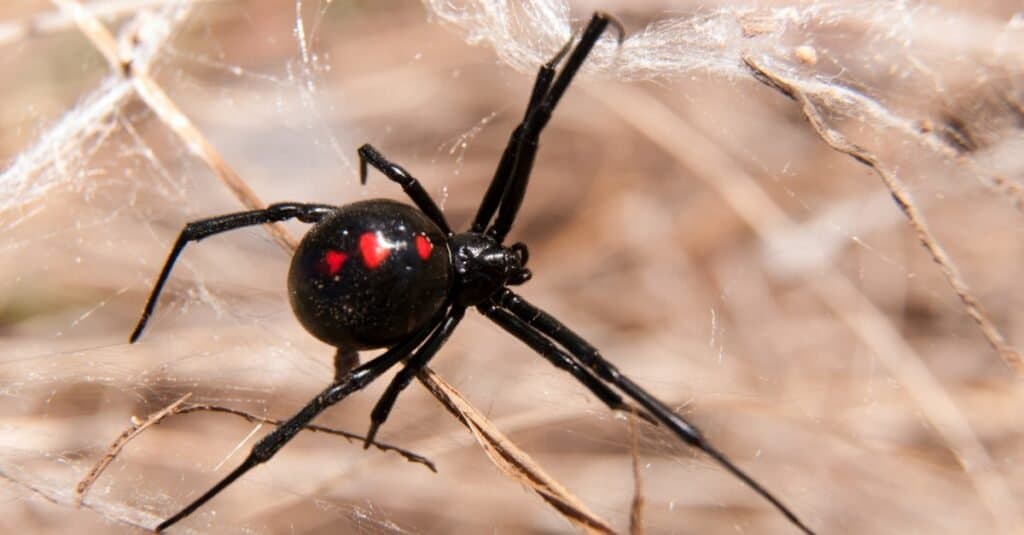
The black widow spreads its webs between flower pots and the corners of gardens.
©Sari ONeal/Shutterstock.com
The southern black widow spider is one of the most venomous arachnids in the country. It is well known for its distinctive black coloring and red hourglass-shaped marking. Its venom is more potent than rattlesnake venom, and any bites require immediate medical attention. You will often find this dangerous spider’s web spread across a structural corner or between two flower pots.
17. Golden Silk Spider

The golden silk spider attaches its web to trees and low shrubs, catching prey like flies, bees, and moths.
©Dave Montreuil/Shutterstock.com
The golden silk spider is a large orange and brown arachnid famous for making sticky cobwebs near hiking areas. If you happen to get bitten by this species, don’t worry. Its venom will only leave a mild irritation at most. This spider attaches its web to trees and low shrubs, catching prey like flies, bees, and moths.
18. American Nursery Web Spider
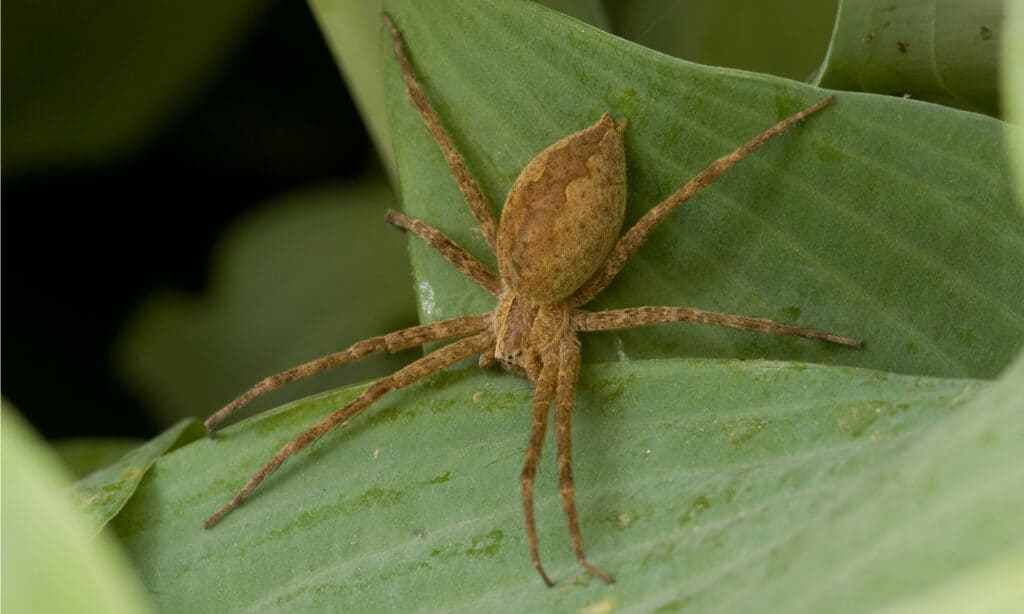
Male American nursery web spiders will tie females’ legs during mating to avoid being eaten afterward.
©SDeming/Shutterstock.com
Often mistaken for a wolf spider, the nursery web spider is similar but distinguishable by its two rows of eyes. This sit-and-wait ambush predator occupies high weeds or low shrubs with plenty of native plant diversity. It uses venom on its prey, but it is ineffectual with humans.
19. Banded Garden Spider
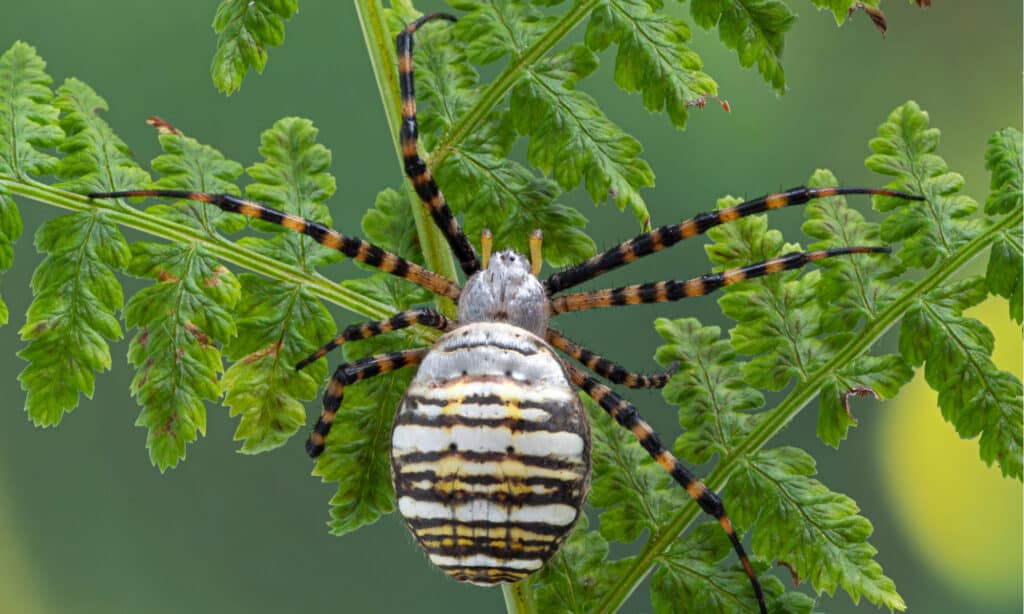
The banded garden spider is pale yellow or silver, with numerous black bands and stripes.
©Ernie Cooper/Shutterstock.com
While the banded garden spider inhabits similar areas as the yellow garden spider, you won’t see it as often. Smaller than other garden spiders, this species is pale yellow or silver with numerous black bands and stripes. You can find its web low to the ground between tall grasses and shrubs. Researchers confirmed that garden spiders engage in sexual cannibalism.
20. Hacklemesh Weaver

You may find the hacklemesh weaver under leaves, stones, and woodpiles.
©Eric Isselee/Shutterstock.com
The hacklemesh weaver hides under bark, leaves, stones, and woodpiles, which makes a garden a perfect place to make its home. It may also make its way to your basement during the winter. This spider is a mahogany color, with lighter legs and a chevron-style shape on its abdomen. This weaver may bite when threatened, but only a mild reaction occurs.
21. Common House Spider
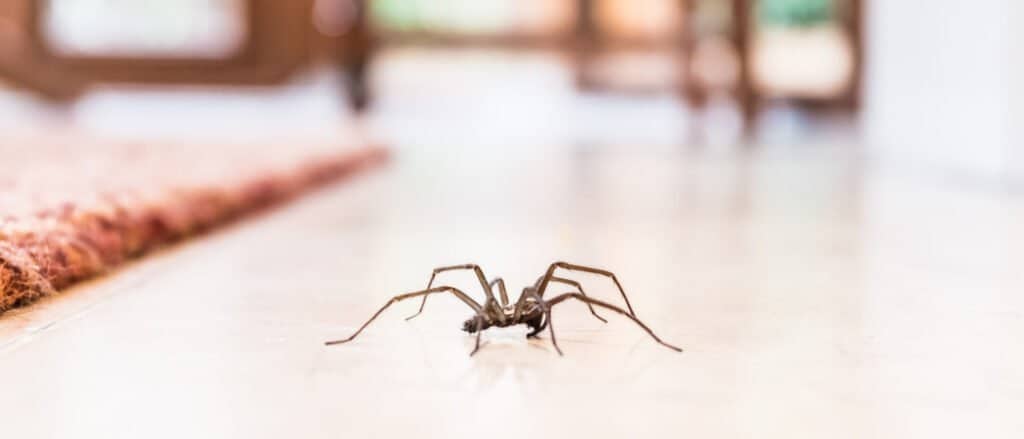
The common house spider isn’t very aggressive but may bite if it feels threatened.
©Christine Bird/Shutterstock.com
You may be more likely to encounter these spiders indoors, but they occasionally find their way to your favorite outdoor spaces as well. The common house spider isn’t very aggressive but may bite if it feels threatened. However, its venom is harmless to humans. Common house spiders have bulb-shaped abdomens and are brown with white and dark patches.
22. Brown Widow Spider

The brown widow spider has varying shades of brown with splotches of tan and brown with black accents.
©Decha Thapanya/Shutterstock.com
The brown widow neither looks like a black widow nor a brown recluse. It has varying shades of brown with splotches of tan and brown with black accents; it has an hourglass shape but is an orange shade versus a bright red. This species won’t typically live in a garden but may inhabit woody vegetation with branches. The brown widow’s bite is poisonous but less so than a black widow’s.
23. Brown Recluse

The brown recluse spider is one of the more dangerous spiders in Texas.
©Physics_joe/Shutterstock.com
The brown recluse, or “fiddleback” spider, has a violin-shaped marking on its dorsum and is one of the more dangerous spiders in the state. Its venom can cause severe wounds and may require immediate medical attention. Be cautious when working in your garden around dense vegetation and piles of debris.
24. Southwestern Trapdoor Spider
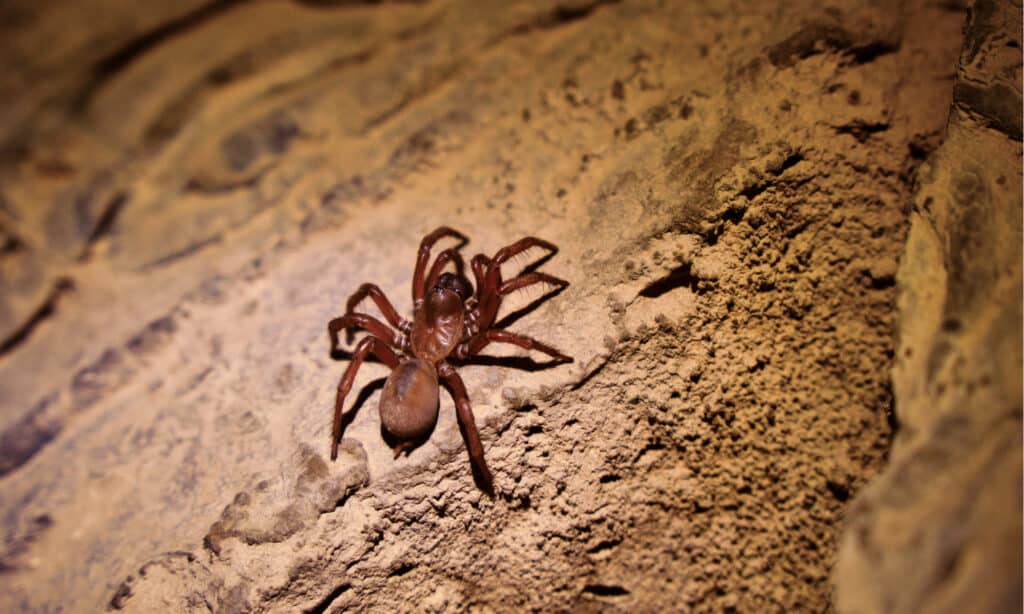
Trapdoor spiders are often sighted near pools and gardens in the Southwest.
©Geartooth Productions/Shutterstock.com
The trapdoor spider is found throughout the Southwestern United States, with reported sightings near gardens and pools. This large, hairy arachnid is aggressive towards prey but harmless towards humans. However, its bite is venomous and considered low-toxic. The trapdoor spider gets its name from the clever burrow it makes that resembles a door.
25. American Green Crab Spider

The American green crab spider features extremely long front legs designed to help it catch prey.
©iStock.com/Del Henderson Jr
Like a crab, the American green crab spider can walk forwards, backward, and sideways. The busy season for spotting this arachnid is from May through August in fields, woodlands, and occasionally gardens. Crab spiders will sit inside flowers for hours before their favorite prey comes by, and they can sneakily ambush.
26. Northern Crab Spider

The northern crab spider has tiny hairs all over its abdomen and legs.
©1Roman Makedonsky/Shutterstock.com
This foliage spider has tiny hairs all over its abdomen and legs. Its natural color is a bright greenish-yellow, but this species has so many possible color combinations it’s hard even for experts to tell them apart. Like other crab spiders, the northern crab spider resembles a crustacean, and instead of spinning webs, it waits on flowers and grabs its victims.
27. White Banded Crab Spider

White-banded crab spiders sit on flowers waiting to ambush prey.
©Georgi Baird/Shutterstock.com
The white-banded crab spider has a white line that runs through the plane of its eyes and two solid front legs, which it uses to grab prey, similar to crabs. Its color will change from white to yellow depending on the color of the flower it uses to target pollinators. It also consumes the nectar from flowers for its nutrients. This crab spider has a high-temperature tolerance, able to withstand summer days as high as 118°.
28. Goldenrod Crab Spider
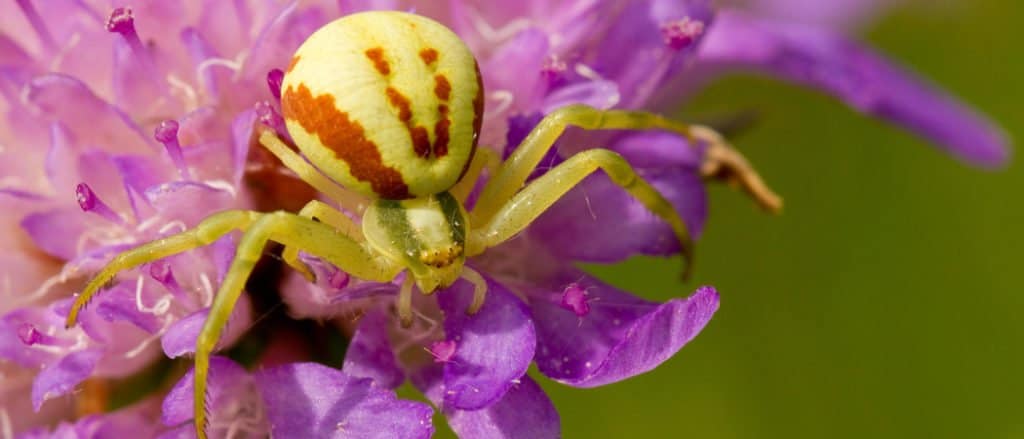
The goldenrod crab spider alters its coloring for camouflage and can blend in with several flower species.
©Radka Palenikova/Shutterstock.com
With its legs out at its sides like a crab, this arachnid stealthily catches bees and flies while sitting atop flowers. The goldenrod crab spider alters its coloring for camouflage and can blend in with several flower species such as daisies, goldenrods, and other white and yellow plants. You will most likely spot this spider during the summer in gardens and meadows when pollinators are in abundance.
29. Hogna antelucana
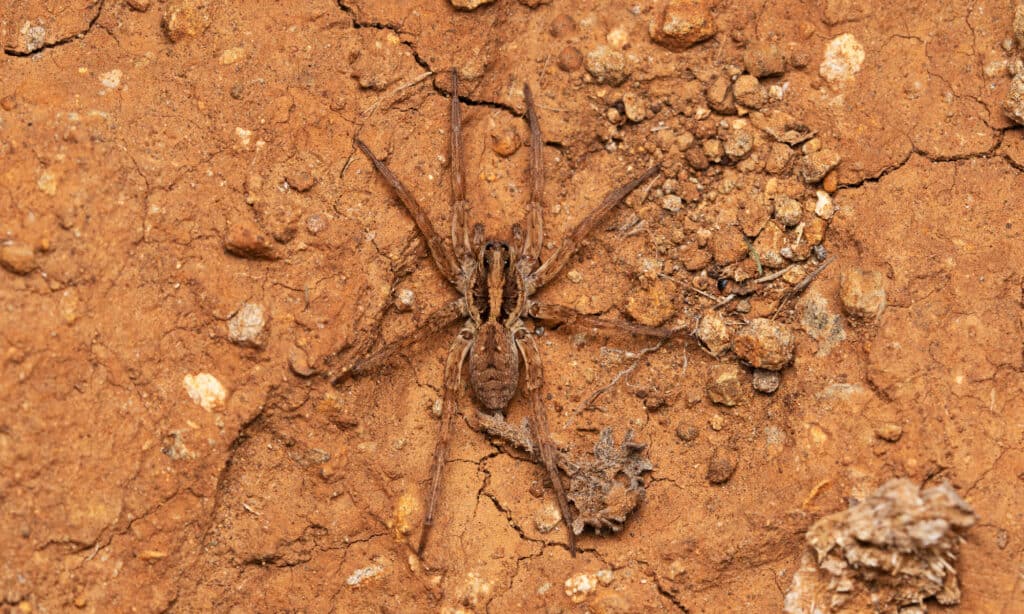
The Hogna antelucana is a species of wolf spider commonly found in backyards across the United States.
©iStock.com/ePhotocorp
The Hogna antelucana is a species of wolf spider commonly found in backyards across the United States. Wolf spiders are not known for their flashy appearance and use their neutral colors and patterns to blend with their surroundings. Wolf spiders are adaptable and live in many different habitats, but you will most often see them in garden areas or hiding in storage sheds.
Now that you know the 29 common garden spiders in Texas, find out if your garden contains dangerous dwellers or friendly helpers.
Bonus: What Keeps Spiders Away

Tea tree oil is an excellent alternative to commercial pesticides, as the scent repels spiders.
©AmyLv/Shutterstock.com
While most of you are probably okay with spiders setting up shop in your gardens due to their consumption of other insects that could pose a threat to vegetation, spiders are not so welcome in the house, especially the poisonous kind. What are some ways to keep these creepy crawlies out of your home?
As spiders penetrate structures through holes and cracks, you can check for possible entryways with a flashlight. If the light gets through from the inside to the outside, you should fill that hole or crevice with an appropriate product.
Keeping your yard free of debris and overgrown vegetation helps cut down on areas spiders would gravitate to. Caulking doors and windows is also a good strategy to keep them out.
Spiders hate certain scents, so scented essential oils can help deter them like peppermint, tea-tree, lavender, and rose. You can add 15-20 drops of a particular oil in a water bottle mixed with water and spritz it around your house. They also hate the smell of cinnamon and vinegar, so these scents can be used similarly.
Rubbing lemon or orange peels on the baseboards along your walls, on window sills, and on other surfaces can also repel spiders, who dislike citrus smells. Furniture polish and cleaning products with lemon scent can also help.
Regular cleaning inside your home, especially in areas that are dark or less frequented, is necessary to keep spiders from setting up residence. It’s also important to keep an eye on fruit bowls, as they can attract spiders.
The photo featured at the top of this post is © Sari ONeal/Shutterstock.com
Thank you for reading! Have some feedback for us? Contact the AZ Animals editorial team.






